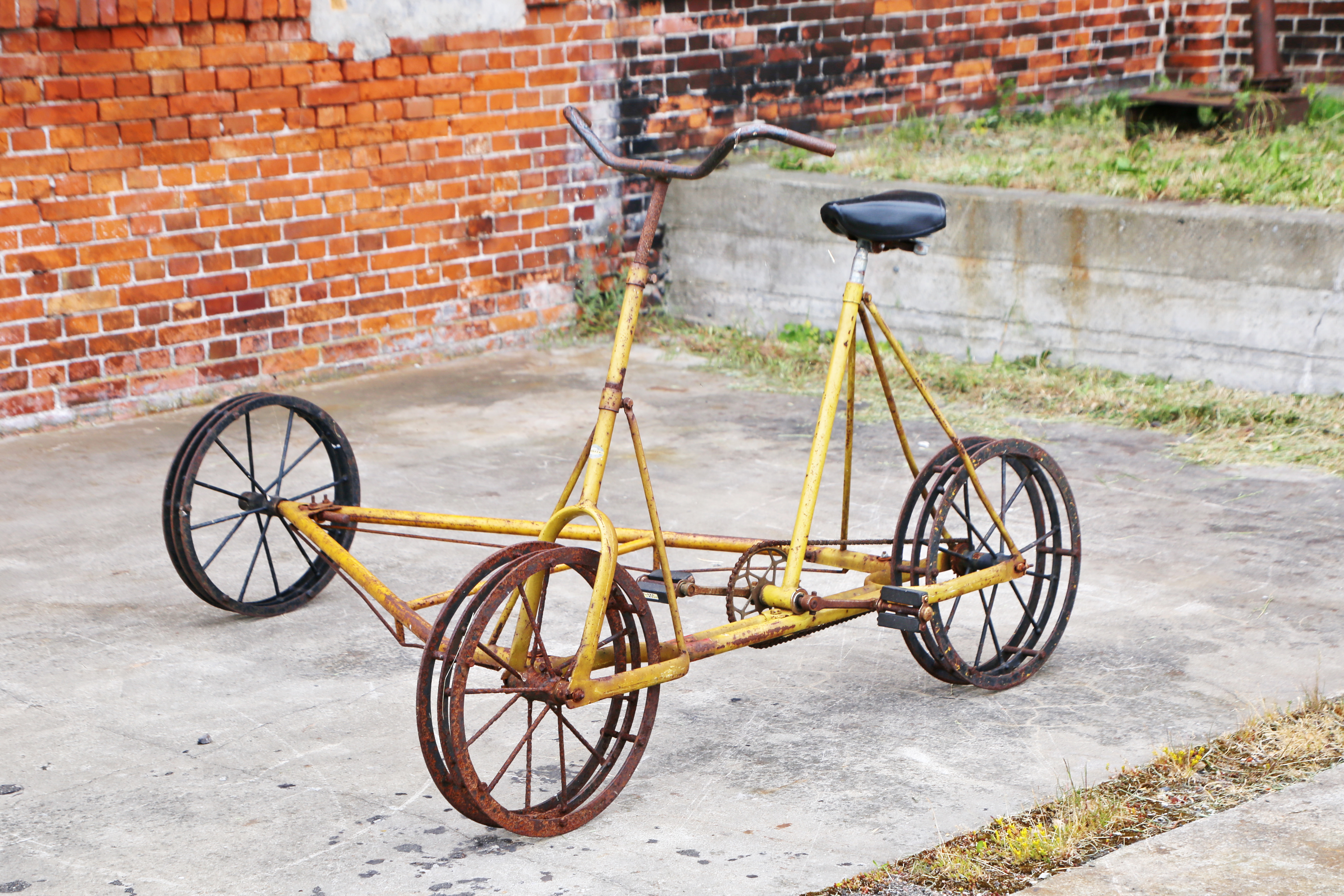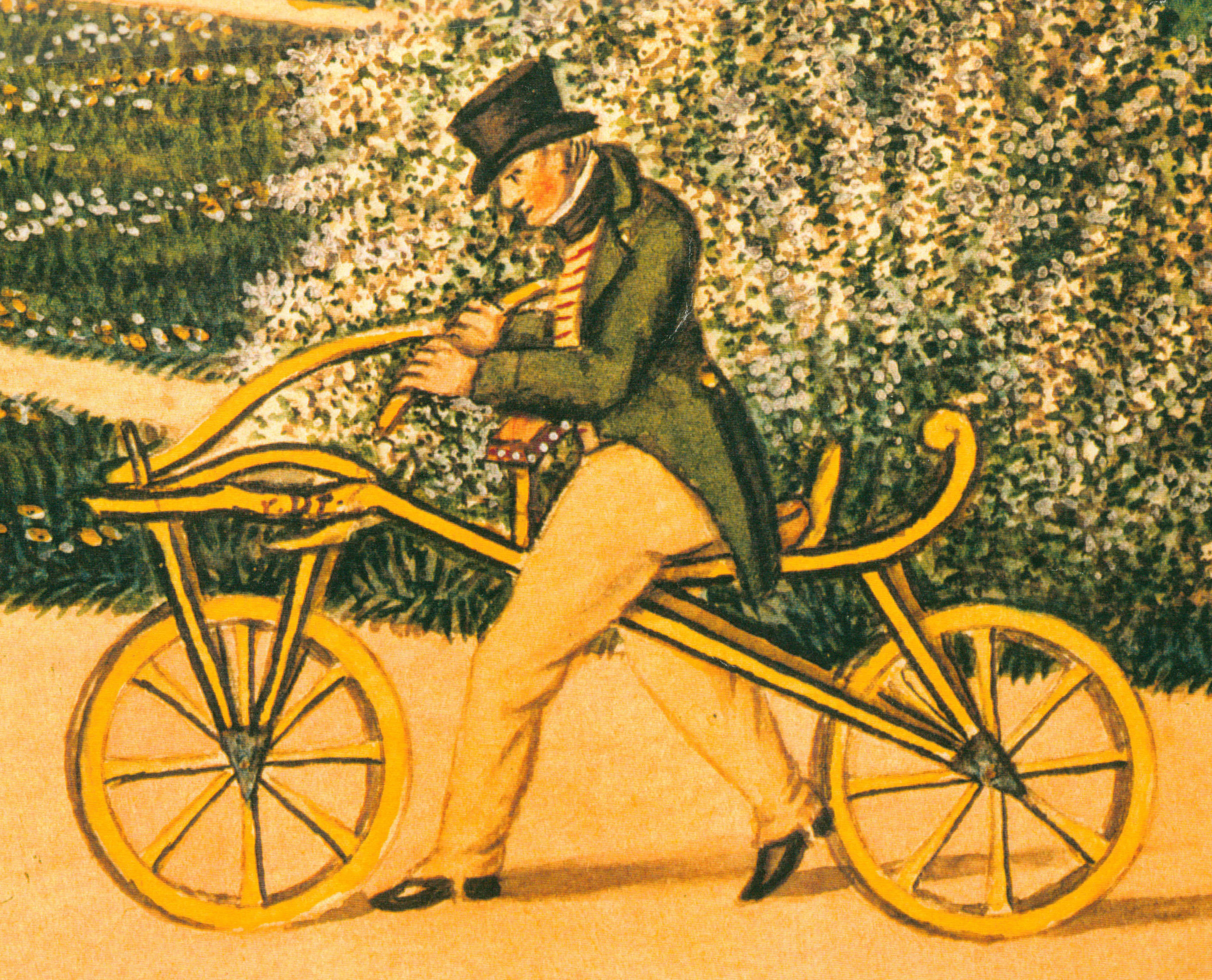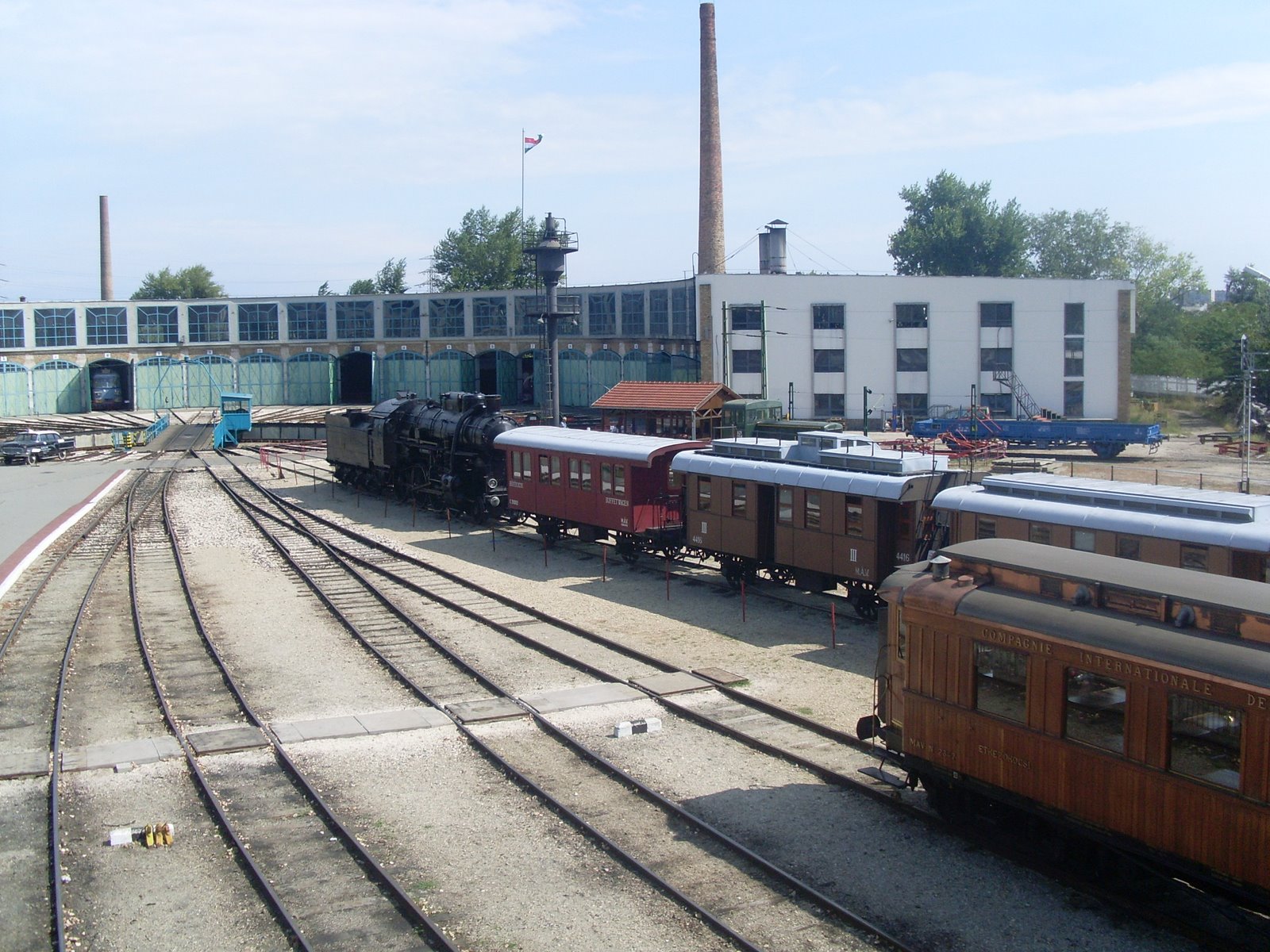|
Draisine
A draisine () is a light auxiliary rail vehicle, driven by service personnel, equipped to transport crew and material necessary for the maintenance of railway infrastructure. The eponymous term is derived from the German inventor Baron Karl Drais, who invented his ''Laufmaschine'' (German for "running machine") in 1817, which was called ''Draisine'' in German (''vélocipède'' or ''draisienne'' in French) by the press. It is the first reliable claim for a practically used precursor to the bicycle, basically the first commercially successful two-wheeled, steerable, human-propelled machine, nicknamed hobby-horse or dandy horse. Later, the name draisine came to be applied only to the invention used on rails and was extended to similar vehicles, even when not human-powered. Because of their low weight and small size, they can be put on and taken off the rails at any place, allowing trains to pass. In the United States, motor-powered draisines are known as speeders while human- ... [...More Info...] [...Related Items...] OR: [Wikipedia] [Google] [Baidu] |
Handcar
A handcar (also known as a pump trolley, pump car, rail push trolley, push-trolley, jigger, Kalamazoo, velocipede, or draisine) is a railroad car powered by its passengers, or by people pushing the car from behind. It is mostly used as a railway maintenance of way or mining car, but it was also used for passenger service in some cases. A typical design consists of an arm, called the walking beam, that pivots, seesaw-like, on a base, which the passengers alternately push down and pull up to move the car. Use It is a simple trolley, pushed by two or four people (called trolleymen), with hand brakes to stop the trolley. When the trolley slows down, two trolleymen jump off the trolley, and push it till it picks up speed. Then they jump into the trolley again, and the cycle continues. The trolleymen take turns in pushing the trolley so that the speed is maintained and two people do not get tired. Four people also required to safely lift the trolley off the rail tracks when a train app ... [...More Info...] [...Related Items...] OR: [Wikipedia] [Google] [Baidu] |
Karl Drais
Karl Freiherr von Drais (full name: Karl Friedrich Christian Ludwig Freiherr Drais von Sauerbronn) (29 April 1785 – 10 December 1851) was a noble German forest official and significant inventor in the Biedermeier period. He was born and died in Karlsruhe. He is seen as "the father of the bicycle". Bicycle Drais was a prolific inventor, who invented the Laufmaschine ("running machine"), also later called the velocipede, ''draisine'' (English) or ''Parisienne'' ( French), also nicknamed the hobby horse or dandy horse. This was his most popular and widely recognized invention. It incorporated the two-wheeler principle that is basic to the bicycle and motorcycle and was the beginning of mechanized personal transport. This was the earliest form of a bicycle, without pedals. His first reported ride from Mannheim to the "Schwetzinger Relaishaus" (a coaching inn, located in "Rheinau", today a district of Mannheim) took place on 12 June 1817 using Baden's best road. Karl rode his ... [...More Info...] [...Related Items...] OR: [Wikipedia] [Google] [Baidu] |
Railroad Speeder
A speeder (also known as a section car, railway motor car, putt-putt, track-maintenance car, crew car, jigger, trike, quad, trolley, inspection car, or a draisine) is a small railcar formerly used around the world by track inspectors and work crews to move quickly to and from work sites. Although slow compared to a train or car, it is called ''speeder'' because it is faster than a human-powered vehicle such as a handcar. Motorised inspection cars date back to at least 1896, when it was reported that the U.S. Daimler Motor Company created a gasoline-powered rail inspection car capable of 15 mph (24 km/h). In the 1990s, many speeders were replaced by pickup trucks or sport utility vehicles with additional flanged wheels that could be lowered for travelling on rails, called "road–rail vehicles" or hi-rails for "highway-railroad". Speeders are collected by hobbyists, who refurbish them for excursions organized by the North American Railcar Operators Association in the U.S ... [...More Info...] [...Related Items...] OR: [Wikipedia] [Google] [Baidu] |
Bicycle
A bicycle, also called a pedal cycle, bike or cycle, is a human-powered or motor-powered assisted, pedal-driven, single-track vehicle, having two wheels attached to a frame, one behind the other. A is called a cyclist, or bicyclist. Bicycles were introduced in the 19th century in Europe. By the early 21st century, more than 1 billion were in existence. These numbers far exceed the number of cars, both in total and ranked by the number of individual models produced. They are the principal means of transportation in many regions. They also provide a popular form of recreation, and have been adapted for use as children's toys, general fitness, military and police applications, courier services, bicycle racing, and bicycle stunts. The basic shape and configuration of a typical upright or "safety bicycle", has changed little since the first chain-driven model was developed around 1885. However, many details have been improved, especially since the advent of modern ... [...More Info...] [...Related Items...] OR: [Wikipedia] [Google] [Baidu] |
Dandy Horse
The dandy horse, a derogatory term for what was first called a Laufmaschine (in German), then a vélocipède or draisienne (in French and then English), and then a pedestrian curricle or hobby-horse, or swiftwalker, is a human-powered vehicle that, being the first means of transport to make use of the two-wheeler principle, is regarded as the forerunner of the bicycle. The dandy horse is a foot-propelled vehicle, powered by the rider's feet on the ground instead of the pedals of later bicycles. It was invented by Karl Drais (who called it a ''Laufmaschine'' "running machine" in 1817, and then patented by him in France in February 1818 using the term ''vélocipède''. It is also known as a ''Draisine'' ( in German, a term used in English only for light auxiliary railcars regardless of their form of propulsion), and as a ''draisienne'' ( in French and English. In English, it is also sometimes still known as a velocipede, but that term now also has a broader meaning. History Th ... [...More Info...] [...Related Items...] OR: [Wikipedia] [Google] [Baidu] |
Hungarian Railway Museum
The Magyar Vasúttörténeti Park ("Hungarian Railway History Park") is a railway museum located in Budapest, Hungary at a railway station and workshop of the Hungarian State Railways (MÁV), the former Budapest North Depot. The museum covers more than 70,000 square meters and it features over one hundred exhibits, mostly including railway vehicles and equipment.Hungarian Railway Museum – History , accessed March 28, 2010. Overview The museum has a fleet with many locomotives of the Hungarian State Railways, ranging from steam engines to |
Dodge WC Series
The Dodge WC series, sometimes nicknamed 'Beeps', were a prolific range of light 4WD and medium 6WD military utility trucks, produced by Dodge / Fargo during World . Together with the -ton jeeps produced by Willys and Ford, the Dodge tons and tons made up nearly all of the light 4WD trucks supplied to the U.S. military in WWII – with Dodge contributing some 337,500 4WD unitsIncluding the 4,640 VC trucks of 1940 (over half as many as the jeep). Contrary to the versatility of the highly standardized jeep, which was mostly achieved through field modification, the Dodge WCseries came in many different, purpose-built, but mechanically uniform variants from the factory, much akin to the later family of High Mobility Multipurpose Wheeled Vehicles. The WC series evolved out of, and was part of a more extended family of trucks, with great mechanical parts commonality, that included open- and closed-cab cargo trucks and weapons carriers, (radio) command cars, reconnaissance v ... [...More Info...] [...Related Items...] OR: [Wikipedia] [Google] [Baidu] |
Laufmaschine
The dandy horse, a derogatory term for what was first called a Laufmaschine (in German), then a vélocipède or draisienne (in French and then English), and then a pedestrian curricle or hobby-horse, or swiftwalker, is a human-powered vehicle that, being the first means of transport to make use of the two-wheeler principle, is regarded as the forerunner of the bicycle. The dandy horse is a foot-propelled vehicle, powered by the rider's feet on the ground instead of the pedals of later bicycles. It was invented by Karl Drais (who called it a ''Laufmaschine'' "running machine" in 1817, and then patented by him in France in February 1818 using the term ''vélocipède''. It is also known as a ''Draisine'' ( in German, a term used in English only for light auxiliary railcars regardless of their form of propulsion), and as a ''draisienne'' ( in French and English. In English, it is also sometimes still known as a velocipede, but that term now also has a broader meaning. History Th ... [...More Info...] [...Related Items...] OR: [Wikipedia] [Google] [Baidu] |
Willys MB
The Willys MB and the Ford GPW, both formally called the U.S. Army Truck, -ton, 4×4, Command Reconnaissance, commonly known as the Willys Jeep, Jeep, or jeep, and sometimes referred to by its List of U.S. military vehicles by supply catalog designation#G500 to G599, supply catalogue designation G503,According to its United States Army Ordnance Corps Supply Catalog designation, 'G-number', or SNL nr. — a group number for ordering parts, based on a List of U.S. Army weapons by supply catalog designation, Standard Nomenclature List. were highly successful American Off-road vehicle, off-road capable Military light utility vehicle, light military utility vehicles, built in large numbers to a single standardized design, for the United States and the Allies of World War II, Allied forces in World War II, World War II from 1941 until 1945. The jeep became the primary light-wheeled multi-role vehicle of the United States military and its allies, with President Eisenhower once c ... [...More Info...] [...Related Items...] OR: [Wikipedia] [Google] [Baidu] |
Khabarovsk Bridge
Khabarovsk Bridge is a road and rail bridge built in 1999. It crosses the Amur River in eastern Russia, and connects the urban-type settlement of Imeni Telmana in the Jewish Autonomous Oblast with the city of Khabarovsk in Khabarovsk Krai. Until that time an older bridge built in 1916 existed nearby. History Railway bridge built 1916 Khabarovsk Bridge was originally built in 1916 as a single-track structure that carried the Trans-Siberian Railway line across the Amur River near the city of Khabarovsk, Russia. The bridge remained the longest bridge in Imperial Russia and the Soviet Union for decades, having a length of . The bridge construction was supposed to cost 13,500,000 Russian rubles, and to be done in only 26 months to a design by the eminent bridge builder Lavr Proskuryakov. However, a year after construction began on 30 July 1913, the First World War broke out. Since the bridge was being constructed by Warsaw-based K. Rudzki i S-ka company and the spans were m ... [...More Info...] [...Related Items...] OR: [Wikipedia] [Google] [Baidu] |
Railbus
A railbus is a lightweight passenger railcar that shares many aspects of its construction with a bus, typically having a bus (original or modified) body and four wheels on a fixed base, instead of on bogies. Originally designed and developed during the 1930s, railbuses have evolved into larger dimensions, with characteristics similar in appearance to a light railcar, with the terms ''railcar'' and ''railbus'' often used interchangeably. Railbuses designed for use specifically on little-used railway lines were commonly employed in countries such as Germany, Italy, France, the United Kingdom and Sweden. Today, railbuses are being replaced by modern light DMU railcar designs. Modern diesel-electric railcars, which can be run coupled as multiple units, like the Stadler RS1, the RegioSprinter of Siemens or the successor Siemens Desiro share role and specifications with railbuses (albeit with improvements in noise, low floor design, fuel efficiency, speed and other measures) but ... [...More Info...] [...Related Items...] OR: [Wikipedia] [Google] [Baidu] |
GAZ-13
The GAZ-13 Chaika (Seagull) is an automobile manufactured by the Gorkovsky Avtomobilny Zavod (GAZ, Gorky Automobile Plant) from 1959 to 1981 as a generation of its Chaika marque. It is famously noted for its styling which resembled 1950s Packard automobiles. History The GAZ-13 Chaika debuted in 1958. It was produced from 1959 to 1981, with 3,179 built in all. The GAZ-13 was powered by a 195-hp SAE gross 5.5 L V8 with a 4-brl carburetor called the ZMZ-13, a modified version of which with a reduced compression ratio and smaller 2-brl carburetor would be used on the GAZ-53 truck, along with other parts of the Chaika. and driven through a push-button automatic transmission of a similar design to the Chrysler PowerFlite unit. It was offered as a saloon (GAZ-13), limousine (GAZ-13A), and four-door cabriolet (GAZ-13B) with an electrohydraulic top. The cabriolet was made in 1961 and 1962 for official parades. RAF in Riga produced the GAZ-13A Universal, an estate, in the 1960s in Riga; ... [...More Info...] [...Related Items...] OR: [Wikipedia] [Google] [Baidu] |




.jpg)


.jpg)

